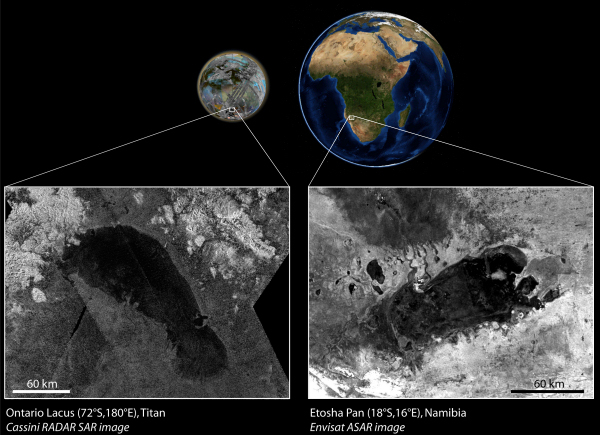Far-off cousin of part-time African lake found on Titan
19 April 2012
A region on Saturn's moon Titan has been found to be similar to the Etosha Pan in Namibia, Africa. Both are ephemeral lakes - large, shallow depressions that sometimes fill with liquid. |
| Ephemeral lakes on Titan and Earth. Credit: Cassini radar image: JPL/NASA. Envisat radar image: ESA. Composite image: LPGNantes |
Ontario Lacus is the largest lake in the southern hemisphere of Saturn's moon, Titan. It is a little smaller than its namesake, Lake Ontario in North America, but otherwise differs from it in some major ways.
It is filled with liquid hydrocarbons, not water, and it is only a few metres deep at most, located in an extremely shallow depression in a flat sedimentary basin, surrounded by small mountain ranges.
In addition, a new study shows that these landforms and the climatic conditions in the region are similar to those of semi-arid regions on Earth, such as the salt pans of southern Africa.
The observations were made by the Cassini orbiter, part of the NASA, ESA and Italian Space Agency Cassini-Huygens mission to Saturn's system.
While Ontario Lacus was previously thought to be permanently filled with liquid methane, ethane and propane, these latest observations, published in the journal Icarus, suggest otherwise.
By combining data from Cassini's imaging, spectroscopic and radar instruments - each of which observed Ontario Lacus twice - scientists led by Thomas Cornet of the Université de Nantes, France, found evidence for channels etched into the lake bed within the southern boundary of the depression. These channels remained visible between December 2007 and January 2010, each time the spatial resolution was able to resolve them.
"We conclude that the solid floor of Ontario Lacus is most probably exposed in those areas," says Cornet.
By comparing observations made by Cluster and Mars Express, the scientists found that the rate of increase in O+ losses was the same order of magnitude on both planets under these different conditions. Since the scientists have already shown the protective role of Earth's magnetic field, they propose that the similar rate of increase is attributed to Mars' greater distance from the Sun. This is the first observational evidence that distance plays an important role in the evolution of planetary atmospheres.
In addition, Cassini shows sediments around Ontario Lacus that also indicate the liquid level has been higher in the past.
This is similar to ephemeral lakes on Earth. The researchers suggest its nearest cousin is the Etosha Pan in Namibia. This salt lake bed fills with a shallow layer water, provided by the rise of the underground aquifer during the rainy season, before evaporating to leave sediments like tide marks showing the previous extent of the water.
Cornet and colleagues thus believe that Ontario Lacus is also the result of subsurface hydrocarbon fluids occasionally welling up and flooding the depression, before then partially drying out again.
Beyond Earth, Titan is the only other world known to bear stable liquids on its surface. Where Earth has a water cycle, Titan has a full hydrocarbon cycle, based on hydrogen, carbon and nitrogen, taking place between the atmosphere, the surface and the subsurface. Titan's lakes are an integral part of this process.
"These results emphasise the importance of comparative planetology in modern planetary sciences: finding familiar geological features on alien worlds like Titan allows us to test the theories explaining their formation," says Nicolas Altobelli, ESA's Cassini-Huygens project scientist.
Notes for editors
The Cassini-Huygens mission is a cooperative project of NASA, the European Space Agency and ASI, the Italian space agency. NASA's Jet Propulsion Laboratory, a division of the California Institute of Technology in Pasadena, manages the mission for NASA's Science Mission Directorate, Washington, DC. The Cassini orbiter was designed, developed and assembled at JPL. The radar instrument was built by JPL and the Italian Space Agency, working with team members from the US and several European countries. JPL is a division of the California Institute of Technology in Pasadena.
Related publication
"Geomorphological Significance of Ontario Lacus on Titan: Integrated interpretation of Cassini VIMS, ISS and RADAR data and comparison with the Etosha Pan (Namibia)," by T. Cornet, O. Bourgeois, S. Le Mouélic, S. Rodriguez, C. Sotin, T. Lopez Gonzalez, G. Tobie, C. Fleurant, J.W. Barnes, R.H. Brown, K.H. Baines, B.J. Buratti, R.N. Clark and P.D. Nicholson, Icarus 218(2), 788-806, April 2012, doi:10.1016/j.icarus.2012.01.013
Contacts
Markus Bauer
ESA Science and Robotic Exploration Communication Officer
Tel: +31 71 565 6799
Mob: +31 61 594 3 954
Email: markus.bauer esa.int
esa.int
Thomas Cornet
Laboratoire de Planétologie et Géodynamique de Nantes - CNRS/Université de Nantes
Tel: +33 2 51 12 55 84
Email: thomas.cornet univ-nantes.fr
univ-nantes.fr
Nicolas Altobelli
ESA Cassini-Huygens Project Scientist
Tel: +34 91 813 1201
Email: nicolas.altobelli sciops.esa.int
sciops.esa.int
(This article was originally published on ESA's Space Science Portal.)

